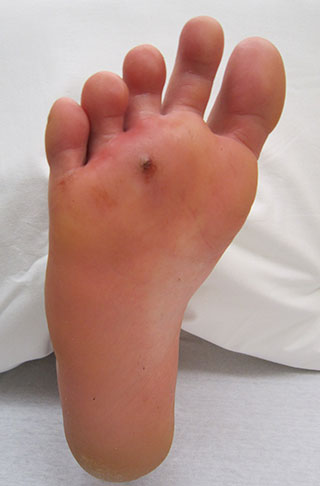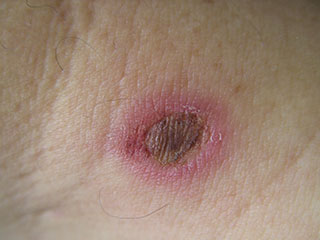DEFINITIONS OF WOUNDS
A wound occurs when there is an interruption of the normal make-up and function of the skin. Wounds may be described as either acute or chronic (Baranoski & Ayello, 2022). Wounds interfere with the structure and function of tissues beneath the skin surface and can extend into body cavities and deeper organs. Wounds can occur in otherwise healthy human beings at any stage in their lifespan. They can be as simple as a scrape or as a complex as a deep, life-threatening wound affecting internal organs. Wounds affect millions of individuals, making it imperative to develop standard terminologies to define and classify wounds (WOCN, 2022).
By Depth
One way of classifying wounds is according to the amount of tissue destruction involved (WOCN, 2022). The terms partial thickness and full thickness are used to describe wounds of varying depths. A wound that is limited to the epidermis and the dermis is a partial-thickness wound. A wound that extends beyond the dermal layers is considered a full-thickness wound.
By Time
Another way to classify wounds is according to the length of time they have existed. Acute wounds are newly formed wounds that move through the process of healing in an orderly and efficient manner. The length of time it takes an acute wound to heal varies depending on the size, depth, and manner of wound closure (WOCN, 2022; Shah et al., 2018). Chronic wounds, on the other hand, do not adhere to the normal healing trajectory and can be present for months or years (Baranoski & Ayello, 2020).
ACUTE WOUNDS
Acute wounds happen suddenly and are normally related to trauma or injury. Such a traumatic wound is also often a mixture of types. Types of acute wounds are described below:
- Lacerations are tears. When made by a knife-like object, a laceration is a narrow, deep wound with sharp edges. When made by a blunt object, a laceration is a rip with jagged edges.
- Crushes or contusions are compression wounds. A crush wound bruises and damages the skin and the underlying tissue, although the skin can remain closed in some crush wounds.
- Punctures are narrow, deep wounds. Typically, punctures have small openings with sharp edges. Puncture wounds have a relatively high risk of infection. (See photo below.)
- Avulsions are wounds in which tissue has been torn out. Sometimes, the avulsed tissue remains partly connected to its normal surroundings.
- Burns are wounds made by external destructive energy (e.g., heat) or by external chemicals (e.g., acid). First-degree burns are superficial and red. Second-degree wounds include damage to the dermis and produce blisters. Third-degree burns go deeper than the dermis and produce dry, dead tissue. (See photo below.)

Infected puncture wound. (Source: James Heilman, MD, CC BY-SA 3.0.)

Second-degree burn, with some evidence of infection around central sloughing area. (Source: Peter Ellis, CC BY-SA 3.0.)
CHRONIC WOUNDS
There are several definitions for a chronic wound. It can be defined as a wound that does not heal within a realistic time frame, usually three months (Slachta, 2019). It can also be defined as an acute wound that is unable to move through the different phases of healing and usually stalls in the inflammatory phase of healing (Shah et al., 2018). Other terms used to describe chronic wounds include delayed healing, recalcitrant, stalled, and hard-to-heal (Baranoski & Ayello, 2020).
Chronic wounds are also classified by the underlying causative factor or disease process and include pressure ulcers/injuries, diabetic ulcers, arterial and venous ulcers, and nonhealing palliative wounds.
It is important to remember that all chronic wounds start out as acute wounds. A surgically dehisced wound is an example of an acute wound that develops into a chronic wound.